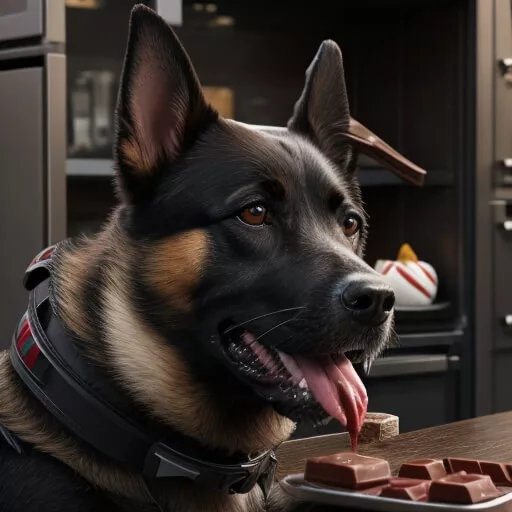How Much Chocolate Can Kill a Dog?

As a dog owner, it’s essential to be aware of the potential dangers lurking in our homes, and one of the most common hazards is chocolate. While chocolate is a delicious treat for humans, it can be deadly for our canine companions. Dogs have a different metabolism than people, and certain substances in chocolate, such as theobromine and caffeine, are toxic to them.
During holidays like Valentine’s Day, Easter, Halloween, and Christmas, the risk of chocolate poisoning in dogs increases, as these are times when people often have chocolate on hand. No matter the occasion, it’s crucial to keep chocolate out of reach to ensure the safety and well-being of our furry friends. In this article, we’ll explore the dangers of chocolate for dogs, how much chocolate can be harmful, and what to do if your dog consumes chocolate.
Why is Chocolate Toxic to Dogs?
Chocolate is a well-known hazard for dogs due to the presence of two harmful substances: theobromine and caffeine. These compounds belong to a class of chemicals called methylxanthines, which can have various effects on both humans and animals.
Theobromine, the main toxin in chocolate, is very similar to caffeine. Both substances have medicinal uses for humans, such as:
- Diuretics
- Heart stimulants
- Blood vessel dilators
- Smooth muscle relaxants
However, dogs are unable to metabolize theobromine and caffeine as efficiently as humans. This slow processing causes these substances to build up in a dog’s system, leading to illness and potentially severe health issues. The more chocolate a dog consumes, the higher the concentration of these toxic compounds in their body, increasing the risk of poisoning.
In summary, chocolate is toxic to dogs because they cannot metabolize theobromine and caffeine as effectively as humans, leading to a dangerous accumulation of these substances in their system.
Types of Chocolate and Their Toxicity Levels

Not all chocolate is created equal, and the toxicity levels for dogs vary depending on the type of chocolate. Here’s a breakdown of the most common types of chocolate and their potential danger to dogs:
- White Chocolate: White chocolate contains the least amount of theobromine and caffeine, making it the least toxic to dogs. However, it’s still not safe for dogs to consume, as it can cause gastrointestinal upset.
- Milk Chocolate: Milk chocolate has a moderate amount of theobromine and caffeine. While it’s not as toxic as dark chocolate, it can still be harmful to dogs, especially in larger quantities.
- Dark Chocolate: Dark chocolate contains higher levels of theobromine and caffeine, making it more toxic to dogs than milk or white chocolate. Even small amounts of dark chocolate can be dangerous for dogs, particularly smaller breeds.
- Baking Chocolate: Baking chocolate, also known as unsweetened chocolate, has the highest concentration of theobromine and caffeine. It poses the greatest risk to dogs, and even a small amount can be lethal.
- Cocoa Powder: Cocoa powder is another highly toxic form of chocolate for dogs, as it contains concentrated amounts of theobromine and caffeine.
In summary, the toxicity levels of chocolate for dogs vary depending on the type, with white chocolate being the least toxic and baking chocolate and cocoa powder being the most toxic. It’s essential to keep all forms of chocolate away from dogs to prevent accidental ingestion and potential poisoning.
How Much Chocolate Can Be Harmful?
The amount of chocolate that can be harmful to a dog depends on the dog’s size and the type of chocolate. Here are some examples of toxic amounts based on dog size and chocolate type:
- Small Dogs (10 lbs):
- Milk Chocolate: 1 ounce
- Dark Chocolate: 0.3 ounces
- Baking Chocolate: 0.1 ounces
- Medium Dogs (30 lbs):
- Milk Chocolate: 3 ounces
- Dark Chocolate: 1 ounce
- Baking Chocolate: 0.3 ounces
- Large Dogs (60 lbs):
- Milk Chocolate: 6 ounces
- Dark Chocolate: 2 ounces
- Baking Chocolate: 0.6 ounces
- Extra Large Dogs (100 lbs):
- Milk Chocolate: 10 ounces
- Dark Chocolate: 3.3 ounces
- Baking Chocolate: 1 ounce
Please note that these are approximate values, and individual dogs may react differently to chocolate consumption. It’s always best to err on the side of caution and keep all forms of chocolate away from your dog. If you suspect your dog has ingested any amount of chocolate, it’s essential to contact your veterinarian immediately for advice.
Symptoms of Chocolate Poisoning in Dogs

If your dog has ingested chocolate, it’s crucial to be aware of the signs of chocolate toxicity. Here are some common symptoms to watch for:
- Vomiting and diarrhea: These are often the earliest signs of chocolate poisoning in dogs. In mild cases, dogs may simply vomit or have diarrhea a few times and then feel better. However, in severe cases, these symptoms may progress further.
- Increased thirst and urination: Dogs experiencing chocolate toxicity may drink more water than usual and urinate more frequently.
- Panting or restlessness: Affected dogs may exhibit heavy panting or seem restless and unable to settle down.
- Racing heart rate: Chocolate poisoning can cause an elevated heart rate, which may be noticeable if your dog’s heartbeat seems faster than usual.
- Muscle tremors: In more severe cases, dogs may experience muscle tremors or shaking.
- Seizures: Seizures are one of the most severe symptoms of extreme chocolate toxicity in dogs. This may only occur when a dog has ingested a large quantity of chocolate, but it can sometimes mean the toxicity will become fatal without veterinary treatment.
If your dog exhibits any of these symptoms after ingesting chocolate, it’s essential to contact your veterinarian immediately for assistance.
What to Do If Your Dog Eats Chocolate
If your dog consumes chocolate, it’s essential to act quickly and follow these steps:
- Assess the situation: Determine the type and amount of chocolate your dog has consumed. This information will help you and your veterinarian understand the severity of the situation.
- Call your veterinarian: Contact your veterinarian immediately for advice. If your regular vet is unavailable, consider calling an emergency veterinarian or a pet poison helpline.
- Follow your veterinarian’s advice: Your veterinarian may recommend inducing vomiting, monitoring your dog at home, or bringing your dog in for treatment, depending on the amount and type of chocolate consumed and your dog’s size.
- Monitor your dog for symptoms: Keep a close eye on your dog for any signs of chocolate poisoning, such as vomiting, diarrhea, increased thirst, panting, restlessness, or seizures. If you notice any of these symptoms, contact your veterinarian right away.
- Prevent future incidents: To avoid future chocolate-related emergencies, make sure to store chocolate and other toxic foods out of your dog’s reach and educate family members and guests about the dangers of feeding chocolate to dogs.
Remember, it’s always better to err on the side of caution. If you’re unsure whether your dog has consumed a dangerous amount of chocolate, it’s best to consult with a veterinarian for guidance.
Diagnosing and Treating Chocolate Poisoning
If you suspect your dog has consumed chocolate, it’s crucial to consult with a veterinarian as soon as possible. Here’s an overview of the diagnostic process and treatments for chocolate poisoning in dogs:
Diagnosing Chocolate Poisoning
- Physical examination: The veterinarian will perform a thorough physical examination to assess your dog’s overall health and look for any signs of chocolate toxicity.
- Medical history: Providing information about the type and amount of chocolate your dog consumed will help the veterinarian determine the severity of the situation.
- Laboratory tests: Blood tests, urinalysis, and possibly an electrocardiogram (EKG) may be performed to detect any abnormalities or organ damage related to chocolate poisoning.
Treating Chocolate Poisoning
- Inducing vomiting: If your dog has consumed chocolate within the last 1-2 hours, the veterinarian may recommend inducing vomiting to remove the toxic substances from their system.
- Activated charcoal: Administering activated charcoal can help absorb the remaining toxins in your dog’s gastrointestinal tract, preventing further absorption into their bloodstream.
- Intravenous fluids: Fluid therapy can help maintain hydration, support kidney function, and flush the toxins from your dog’s system more rapidly.
- Medications: Depending on your dog’s symptoms, the veterinarian may prescribe medications to control vomiting, seizures, or irregular heartbeats.
- Monitoring: Your dog may need to be closely monitored at the veterinary clinic to ensure their condition doesn’t worsen and to provide any necessary supportive care.
Remember, early intervention is crucial in treating chocolate poisoning in dogs. If you suspect your dog has consumed chocolate, contact your veterinarian immediately for guidance and assistance.
Preventing Chocolate Ingestion
To keep your dog safe and prevent accidental chocolate ingestion, follow these tips:
- Store chocolate securely: Keep chocolate and chocolate-containing products in closed cabinets or on high shelves, out of your dog’s reach.
- Educate family members and guests: Make sure everyone in your household, as well as visitors, understand the dangers of chocolate for dogs and the importance of keeping it out of their reach.
- Supervise your dog: Keep an eye on your dog, especially during holidays or events where chocolate might be more accessible, such as Halloween, Easter, or Christmas.
- Use dog-safe treats: Instead of chocolate, offer your dog treats specifically designed for them. This will satisfy their cravings without putting their health at risk.
- Secure trash cans: Ensure that your trash cans have secure lids to prevent your dog from rummaging through them and finding chocolate or chocolate-containing products.
By following these simple steps, you can help prevent accidental chocolate ingestion and keep your dog safe and healthy.
Safe Alternatives to Chocolate for Dogs
While chocolate is off-limits for dogs, there are plenty of dog-friendly treats that can be given instead. Here are some suggestions for safe and delicious alternatives:
- Carob: Carob is a natural, caffeine-free, and theobromine-free substitute for chocolate. It’s often used in dog treats and can be found in various forms, such as carob chips or carob powder. Carob is safe for dogs and can be used in homemade dog treats or purchased in pre-made carob-flavored treats.
- Peanut Butter: Many dogs love peanut butter, and it can be used as a tasty treat or a filling for toys like Kongs. Just make sure to choose a peanut butter without added sugar, salt, or xylitol, which is toxic to dogs.
- Fruits and Vegetables: Some fruits and vegetables, like apples, bananas, carrots, and green beans, make great low-calorie treats for dogs. Be sure to avoid fruits that are toxic to dogs, such as grapes and raisins.
- Dog-safe “Hot Chocolate”: You can make a dog-safe “hot chocolate” using carob powder, warm water, and a splash of unsweetened almond milk. This warm treat is perfect for cold winter days.
- Dog-friendly Desserts: There are many dog-friendly dessert recipes available, such as peanut butter cookies, pumpkin treats, or frozen yogurt pops. Just make sure to use dog-safe ingredients and avoid any human foods that are toxic to dogs.
By offering these safe alternatives to chocolate, you can treat your dog without putting their health at risk. Remember, moderation is key, and it’s essential to provide a balanced diet for your furry friend.
Conclusion
In this article, we’ve discussed the dangers of chocolate for dogs and the importance of keeping our canine companions safe from this toxic treat. We’ve learned that chocolate contains harmful substances like theobromine and caffeine, which dogs cannot metabolize efficiently, leading to potential poisoning. The toxicity levels of chocolate vary depending on the type, with baking chocolate and cocoa powder being the most dangerous.
It’s crucial to be aware of the symptoms of chocolate poisoning in dogs, such as vomiting, diarrhea, increased thirst, panting, restlessness, and seizures. If your dog ingests chocolate, contact your veterinarian immediately for guidance and follow their advice for treatment.
To prevent chocolate ingestion, store chocolate securely, educate family members and guests, supervise your dog, and offer dog-safe treats as alternatives. By taking these precautions, we can ensure the safety and well-being of our furry friends.
Frequently Asked Questions
- How does chocolate affect a dog’s health?
- Chocolate contains harmful substances like theobromine and caffeine, which dogs cannot metabolize efficiently, leading to potential poisoning.
- What are the toxic ingredients in chocolate that can harm dogs?
- Theobromine and caffeine are the toxic ingredients in chocolate that can harm dogs.
- How much chocolate is considered dangerous for a dog?
- The amount of chocolate that is dangerous for a dog depends on the dog’s size and the type of chocolate. Even small amounts of dark chocolate or baking chocolate can be harmful, especially for smaller breeds.
- Are certain types of chocolate more harmful to dogs than others?
- Yes, baking chocolate and cocoa powder are the most toxic types of chocolate for dogs, while white chocolate is the least toxic.
- What are the symptoms of chocolate poisoning in dogs?
- Symptoms of chocolate poisoning in dogs include vomiting, diarrhea, increased thirst, panting, restlessness, and seizures.
- How long does it take for symptoms to appear after a dog has consumed chocolate?
- Symptoms of chocolate poisoning can appear within a few hours of consumption, but the exact timeframe may vary depending on the amount and type of chocolate ingested.
- What should I do if my dog has eaten chocolate?
- If your dog has eaten chocolate, contact your veterinarian immediately for advice and follow their recommendations for treatment.
- How is chocolate poisoning in dogs diagnosed?
- Chocolate poisoning in dogs is diagnosed through a physical examination, medical history, and laboratory tests, such as blood tests, urinalysis, and possibly an electrocardiogram (EKG).
- What is the treatment for chocolate poisoning in dogs?
- Treatment for chocolate poisoning in dogs may include inducing vomiting, administering activated charcoal, intravenous fluids, medications, and close monitoring at the veterinary clinic.
- Can dogs recover from chocolate poisoning?
- Yes, dogs can recover from chocolate poisoning with prompt and appropriate veterinary treatment. However, severe cases can be fatal if left untreated.
- Are some dog breeds more susceptible to chocolate poisoning than others?
- All dog breeds can be affected by chocolate poisoning, but smaller breeds may be more susceptible due to their size and lower tolerance for the toxic substances in chocolate.
- How can I prevent my dog from eating chocolate?
- To prevent your dog from eating chocolate, store it securely, educate family members and guests, supervise your dog, and offer dog-safe treats as alternatives.
- Is there a safe alternative to chocolate for dogs?
- Safe alternatives to chocolate for dogs include carob, peanut butter, fruits and vegetables, dog-safe “hot chocolate,” and dog-friendly desserts made with dog-safe ingredients.
- What other human foods are toxic to dogs?
- Other human foods that are toxic to dogs include grapes, raisins, onions, garlic, avocado, macadamia nuts, and foods containing xylitol.
- Are there any long-term effects of chocolate poisoning in dogs?
- Long-term effects of chocolate poisoning in dogs are rare if the dog receives prompt and appropriate veterinary treatment. However, severe cases can cause organ damage or even death.
- Can a small amount of chocolate still be harmful to my dog?
- Yes, even a small amount of chocolate can be harmful to your dog, especially if it’s dark chocolate or baking chocolate.
- How do I calculate the toxic dose of chocolate for my dog based on their weight?
- To calculate the toxic dose of chocolate for your dog, consider the type of chocolate, the amount consumed, and your dog’s weight. Consult your veterinarian for guidance.
- Is white chocolate dangerous for dogs?
- White chocolate is less toxic than other types of chocolate due to its low theobromine and caffeine content. However, it’s still not safe for dogs to consume, as it can cause gastrointestinal upset.
- Can dogs develop a tolerance to chocolate over time?
- No, dogs cannot develop a tolerance to chocolate. Even small amounts can be harmful, and repeated exposure increases the risk of poisoning.
- Are there any cases of dogs dying from eating chocolate?
- Yes, there have been cases of dogs dying from eating chocolate, especially when they have consumed large amounts of dark chocolate, baking chocolate, or cocoa powder. Prompt veterinary treatment is crucial to prevent fatalities.
Hi, I’m John and I love dogs. Ever since I was a kid, I always wanted to have a furry friend by my side. I grew up with a golden retriever named Max, who taught me a lot about loyalty, friendship, and fun. He was my best buddy for 12 years, and I miss him every day.

6 thoughts on “How Much Chocolate Can Kill a Dog: A Comprehensive Guide to Protect Your Furry Friend”
Comments are closed.